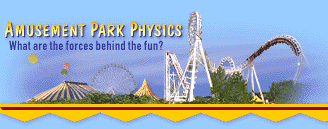
Physics Glossary
acceleration
Objects that are changing their speed or their direction are said to be
accelerating.
The rate at which the speed or direction changes is referred to as
acceleration. Some
amusement park rides (such as roller coasters) are characterized by rapid
changes in
speed and or direction. These rides have large accelerations. Rides
such as the carousel result in small accelerations; the speed and
direction
of the riders change gradually.
balanced and unbalanced forces
A balanced force results whenever two or more forces act upon an object
in such
a way as to exactly counteract each other. As you sit in your seat at this
moment, the
seat pushes upward with a force equal in strength and opposite in direction
to the
force of gravity. These two forces are said to balance each other, causing
you to
remain at rest. If the seat is suddenly pulled out from under you, then you
experience an unbalanced force. There is no longer an upward seat force to
balance
the downward pull of gravity, so you accelerate to the ground.
centripetal force
Motion along a curve or through a circle is always caused by a centripetal
force. This
is a force that pushes an object in an inward direction. The moon orbits the
earth in a circular motion because a force of gravity pulls on the moon in an
inward
direction toward the center of its orbit. In a roller coaster loop, riders
are pushed
inwards toward the center of the loop by forces resulting from the car
seat (at the
loop's bottom) and by gravity (at the loop's top).
energy
Energy comes in many forms. The two most important forms for amusement park
rides are kinetic energy and potential energy. In the absence of external
forces such as
air resistance and friction (two of many), the total amount of an
object's energy
remains constant. On a coaster ride, energy is rapidly transformed from
potential
energy to kinetic energy when falling and from kinetic energy to potential
energy
when rising. Yet the total amount of energy remains constant.
force
A force is a push or a pull acting upon an object. Forces result from
interactions
between two objects. Most interactions involve contact. If you hit the
wall, the wall
hits you back. The contact interaction between your hand and the wall
results in a
mutual push upon both objects. The wall becomes nicked (if hit hard enough) and
your hand hurts. Bumper cars experience mutual forces acting between them
due to
contact during a collision. Some forces can act from a distance without
actual contact
between the two interacting objects. Gravity is one such force. On a free
fall ride,
there is a force of gravitational attraction between the Earth and your
body even
though the Earth and your body are not in contact.
friction
Friction is a force that resists the motion of an object. Friction results
from the close
interaction between two surfaces that are sliding across each other. When
you slam
on your brakes and your car skids to a stop with locked wheels, it is the
force of
friction that brings it to a stop. Friction resists the car's motion.
g
A g is a unit of acceleration equal to the acceleration caused by gravity.
Gravity
causes free-falling objects on the Earth to change their speeds at rates of
about 10 m/s
each second. That would be equivalent to a change in speed of 32 ft/s in each
consecutive second. If an object is said to experience 3 g's of
acceleration, then the
object is changing its speed at a rate of about 30 m/s every second.
gravitational force
Any two objects with mass attract each other with a type of force known as a
gravitational force. The strength of this force depends upon the mass of the two
objects and the distance between them. For objects with masses as large as
the earth
and the sun, these forces are sizeable and have tremendous influence upon the
subsequent motion. For objects such as two persons sitting in a theater,
the force of
gravitational attraction is so small that it is insignificant. In order for
such persons to
increase the force of attraction between them, they must add to their mass (maybe by eating more popcorn). Objects on the earth experience noticeable attractions with the
earth due to
the earth's large mass.
inertia
Inertia is a tendency of an object to resist change in its state of motion.
More massive
objects have more inertia; that is, they have more tendency to resist
changes in
the way they are moving. An elephant has a lot of inertia, for example. If
it is at rest,
it offers a large resistance to changes in its state of rest, and so it's
difficult to move an elephant. On the other hand, a pencil has a small
amount of inertia. It's easy to move a pencil from its state
of rest. More massive objects have more inertia and thus require more force
in order
to change their state of motion.
kinetic energy
Kinetic energy is the energy possessed by an object because of its motion. All
moving objects have kinetic energy. The amount of kinetic energy depends
upon the
mass and speed of the object. A roller coaster car has a lot of kinetic
energy if it is
moving fast and has a lot of mass. In general, the kinetic energy of a
roller coaster
rider is at a maximum when the rider reaches a minimum height.
mass
The mass of an object is a measurement of the amount of material in a
substance.
Mass refers to how much "stuff" is there. Elephants are very massive, since
they contain a
lot of "stuff."
momentum
Momentum pertains to the quantity of motion that an object possesses. Any mass
that is in motion has momentum. In fact, momentum depends upon mass and
velocity, or in other words, the amount of "stuff" that is moving and how
fast the "stuff" is
moving. A train of roller coaster cars moving at a high speed has a lot of
momentum. A tennis ball moving at a high speed has less momentum. And the
building you are in, despite its large mass, has no momentum since it is at
rest.
Newton's First Law of Motion
An object at rest or in uniform motion in a straight line will remain at
rest or in the
same uniform motion unless acted upon by an unbalanced force. This is also
known
as the law of inertia.
Newton's Second Law of Motion
The acceleration of an object is directly proportional to the total
unbalanced force
exerted on the object, and is inversely proportional to the mass of the
object (in other
words, as mass increases, the acceleration has to decrease). The
acceleration of an
object moves in the same direction as the total force. This is also known
as the law of
acceleration.
Newton's Third Law of Motion
If one object exerts a force on a second object, the second object exerts a
force equal
in magnitude and opposite in direction on the object body. This is also
known as the
law of interaction.
period
A motion that repeats itself in cyclic fashion is said to be periodic. The
time for one
complete cycle is known as the period of the motion. The motion of a
second hand has a period of 60 seconds. The periodic rotation of the earth
about its
axis is 24 hours. The periodic motion of an amusement park
pendulum
ride may have a period as high as 10 or 15 seconds.
potential energy
Potential energy is the energy possessed by an object because of its height above the ground. The
amount of potential energy possessed by an object depends on its mass and its
height. A roller coaster car is initially hauled by a motor and chain
system to the top of a
tall hill, giving it a large quantity of potential energy.
speed
Speed is a measurement of how fast an object is moving. Fast-moving objects can
cover large
distances in a small amount of time. They are said to have a high speed. A
roller coaster car
moving at 60 miles per hour would be able to cover a distance of 60 miles
in one
hour if it could maintain this pace.
velocity
The velocity of an object refers to the speed and direction in which it
moves. If you drive north to your work place and your speedometer reads 35 miles per hour, then your velocity is 35 miles per hour in a northward
direction. Velocity is speed with a direction and is
important in understanding bumper car collisions.
weight
Weight is a measurement of the gravitational force acting on an object. The weight of
an object
is expressed in pounds in the U.S. A 180-pound person is experiencing a force of
gravitational attraction to the earth equal to 180 pounds.
weightlessness
Amusement park rides often produce sensations of weightlessness. These sensations result when riders no longer feel an external force acting upon
their bodies.
At the top of the tower of a free-fall ride, a 100-pound rider would feel
100 pounds
of force from the seat pushing as an external force upon her body. The
rider feels her
normal weight. Yet, as she falls from the tower, the seat has fallen
out from
under her. She no longer feels the external force of the seat and
subsequently has a brief
sensation of weightlessness. She has not lost any weight, but feels as
though she has because of the absence of the seat force. In this context,
weightlessness is a sensation and not an actual change in
weight.
|

